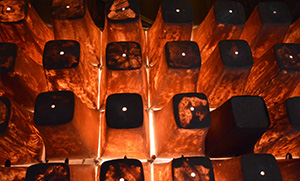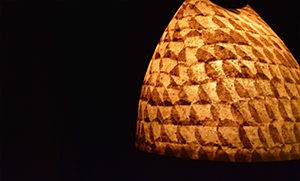HAU Bangkok workshop – 10/2022
World Bamboo Workshop 2022
Ad hoc housing Architecture workshop – 08/2022
HUCE KU Leuven – 08/2022
Chuyển đổi Di sản công nghiệp thành không gian sáng tạo-12/2020
Vietnam Green Building Week-12/2020
Between Two Centuries – 11-2020
Xem Dem Cang Dem – 08-2020


One of the inspirations behind this exhibition is the poem of Phùng cung “Xem đem,” which could be considered a kind of Vietnamese “haiku” poetry. In many poems in this collection, what stands out is not only the night or darkness itself, but also its “opposite:” the light. In his poetic space, light doesn’t limit itself from the context of the night, but rather extends across time into the day. In some poems, light is very much sunlight. But of course, this is not the sunlight that we can touch physically, it is a sunlight of emotion, nostalgia, and contemplation. Perhaps that is why his sunlight is tinted with darker colors like the color of “soy bean” or strawbale. This celebration of sunlight by contemplating in the darkness reminds me of Tanizaki’s book In Praise of Shadow, in which the author celebrates darkness and shadow in many aspects of Japanese culture. By means of shadow, he has explored darkness in its many nuances and subtleties. It seems to me that there exists a gleam light somewhere that glitters around Tanizaki’s darkness, for without it it would be no “shadow.” The space in Phung Cung’s poem, in contrary, seems to be invaded by total darkness, in which light is absolute and shines without obstacles, since it originates from immaterial matters such as memory and emotion. “Xem Dem Cang Dem” exhibition seems to express that concept of contrast between darkness and light. There is not many ways that we can observe the objects in their three-dimensional form, but rather they express themselves as “flat,” bright objects. The light is the object itself. There are no shadows created by the light, but only emittance and projections. If those are indeed the approach, the artists have not many choices other than creating meanings in their uses of color, texture and projected images. In this, I think the two artists have succeeded.
- The projections
- Photos
Timeline

One of the inspirations behind this exhibition is the poem of Phùng cung “Xem đem,” which could be considered a kind of Vietnamese “haiku” poetry. In many poems in this collection, what stands out is not only the night or darkness itself, but also its “opposite:” the light. In his poetic space, light doesn’t limit itself from the context of the night, but rather extends across time into the day. In some poems, light is very much sunlight. But of course, this is not the sunlight that we can touch physically, it is a sunlight of emotion, nostalgia, and contemplation. Perhaps that is why his sunlight is tinted with darker colors like the color of “soy bean” or strawbale. This celebration of sunlight by contemplating in the darkness reminds me of Tanizaki’s book In Praise of Shadow, in which the author celebrates darkness and shadow in many aspects of Japanese culture. By means of shadow, he has explored darkness in its many nuances and subtleties. It seems to me that there exists a gleam light somewhere that glitters around Tanizaki’s darkness, for without it it would be no “shadow.” The space in Phung Cung’s poem, in contrary, seems to be invaded by total darkness, in which light is absolute and shines without obstacles, since it originates from immaterial matters such as memory and emotion. “Xem Dem Cang Dem” exhibition seems to express that concept of contrast between darkness and light. There is not many ways that we can observe the objects in their three-dimensional form, but rather they express themselves as “flat,” bright objects. The light is the object itself. There are no shadows created by the light, but only emittance and projections. If those are indeed the approach, the artists have not many choices other than creating meanings in their uses of color, texture and projected images. In this, I think the two artists have succeeded.

Triển lãm “Xem đêm – càng đêm” tại Manzi được lấy cảm hứng từ tập thơ cùng tên “ Xem đêm” của Phùng Cung – được biết đến như là tập thơ “haiku” của Việt Nam. Ở nhiều bài thơ thuộc bộ sưu tập này, điều nổi bật lên không đơn thuần là bóng tối hay màn đêm mà còn là ánh sáng – sự đối lập của nó. Ánh sáng trong không gian thơ của Phùng Cung không đơn giản chỉ giới hạn trong đêm tối, nó còn mở rộng ra là khoảng thời gian ban ngày. Trong một số bài, ánh sáng của ông lại chủ yếu là ánh sáng mặt trời. Và tất nhiên, đó không phải là ánh sáng mặt trời cái mà chúng ta có thể chạm vào, nó là ánh sáng của cảm xúc, của nỗi nhớ và chiêm nghiệm. Có lẽ đó là lý do ánh sáng của ông lại nhuộm màu tối hơn giống màu của hạt đậu nành hay màu của rơm, rạ. Cách tác giả chiêm nghiệm bóng đêm để ca tụng ánh sáng làm tôi nhớ đến cuốn sách In Praise of Shadow của Tanizaki trong đó tác giả tôn vinh bóng tối và khoảng tối của ánh sáng trong nhiều khía cạnh của văn hóa Nhật Bản. Qua bóng tối, Tanizaki đã khám phá ra những sắc thái và sự tinh tế của màn đêm. Tôi tin rằng có những tia sáng đang lấp lánh đâu đó trong chính màn đêm của ông, chính nó đã làm nên cái mà ông gọi là “đêm”.
Đối với Phùng Cung, không gian của ông ngược lại lại bị xâm chiếm hoàn toàn bởi bóng tối nơi mà ánh sáng là hiển nhiên và phát sáng không gặp phải trở ngại gì bởi nó là ánh sáng bắt nguồn từ trí nhớ và cảm xúc. Có lẽ hai tác giả của triển lãm đã vận dụng quan điểm về bóng tối và ánh sáng của ông để thể hiện trong tác phẩm của mình. Trong bóng tối chúng ta không thể quan sát toàn bộ các vật thể ba chiều mà chỉ có thể thấy chúng dưới các mặt hay những vật phát sáng. Chúng chính là ánh sáng. Không có bóng tối được tạo ra bởi ánh sáng, mà chỉ có sự tán xạ và hình chiếu. Nếu chọn cách tiếp cận này, người nghệ sĩ không có nhiều sự lựa chọn ngoài việc tạo ra ý nghĩa từ màu sắc, chất liệu và hình ảnh được chiếu. Ở triển lãm này, hai nghệ sĩ đã làm được điều đó một cách xuất sắc, đó chính là thành công của họ.





